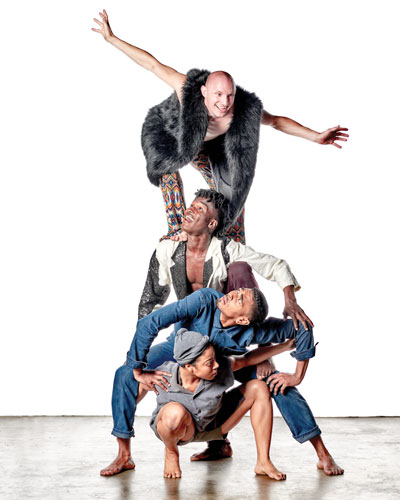
In a dingy warehouse in South Los Angeles, nine dancers rehearse a series of movements as choreographer Sophia Stoller offers corrections. Video projections flash on the walls, ominous music fills the room and a lighting designer twists in fluorescent tubes. The group is busily preparing to stage an immersive dance theater performance called “The Other Side,” premiering May 5 at Gramercy Studios in Los Angeles.
The performance is based on a psychological research study similar to those of the 1960s and ’70s, such as the Stanford prison experiment, in which students assigned to be guards in a mock prison abused students assigned to be prisoners, and Milgram’s shock experiment, in which students meekly followed orders to administer electric shocks to other participants.
In “The Other Side,” the dancers, referred to as “assignees,” are divided into three groups. One group lives miserably and is denied all but basic needs. Another lives contentedly in an average setting. The third group lives an extravagant lifestyle in which every whim and desire are met.
At the beginning of the performance, actors playing the social science researchers, referred to as “executors,” welcome the audience members and treat them as VIP guests and possible donors. The experiment gradually devolves into a barbaric system and the “assignees” turn on one another before focusing their anger on the researchers.
The performance mostly takes place in one large room, with audience members free to move around the performance. In some scenes, the dancers disperse to three smaller rooms, and the audience is encouraged to move from room to room. Meanwhile, closed-circuit cameras connected to television screens allow the “executors” (and the audience members) to observe the “assignees” as they move about their rooms.
In the second half of the performance, the dancers come out of their rooms and begin intermixing. Their costumes make it clear which group each dancer belongs to. Coming together “gives them the realization they’re not each other’s enemy, and that it’s a manufactured situation,” Stoller said.
Stoller, a native of Northern California, is the artistic director for the Los Angeles-based Iris Company, which is producing “The Other Side.” Her father is a sculptor and her mother is a therapist, and her upbringing helped guide her interest in the arts and psychology.
Stoller’s fascination with social science experiments dates back to middle school, when her teacher re-created Jane Elliott’s famous and controversial “blue eyes-brown eyes” exercise. Soon after Rev. Martin Luther King Jr.’s assassination, Elliott divided her class based on their eye color and gave blue-eyed students privileges, like extra snacks, and brown-eyed students impediments, like having to sit in the back of the class. Their test results quickly reflected this treatment. The following week, Elliott reversed their roles and then had the students write about their experience with discrimination.
Stoller’s teacher used colored-dot stickers instead, but the lessons were the same.
“My experience of it was a little bit more tame, but … as seventh-graders, we turned entirely nasty,” Stoller said. “We bonded with our group. There was this sense of group identity that was formed very quickly, and friend groups broke up based on the group they were assigned to.”
Stoller went on to double-major in dance and psychology at UCLA, and studied “how psychological concepts can become embodied physically.” She then spent 10 months living in Israel, dancing full time in an apprenticeship program with Kibbutz Contemporary Dance Company. While in Israel, she also studied the repertoire of Batsheva Dance Company, Inbal Pinto and Vertigo Dance Company.
After returning to Los Angeles, she received her MFA in choreography from CalArts and began teaching at the Gabriella Foundation, a program that offers dance classes to low-income youth in Los Angeles.
The dystopian message of “The Other Side” reflects much of the nation’s current anxiety. Stoller says the 2016 presidential election shaped the story and convinced her to give the show a more political power structure.
“When audience members enter the space, they are shown a video of the experiment’s lead researcher, T.C. Hudson, a “very powerful, wealthy white male who is using his influence to gain more power and control, and framing it in a way that is manipulating the general public to feel that it’s a very good thing,” Stoller said. But as the experiment unravels and the research subjects rebel against the captors, the audience is given a vision of how to overcome oppressive power structures.
“Art needs to offer a beacon of hope in some way, and needs to be a way to inspire people toward a brighter future.” After the election, Stoller said, “that became important to me in a new way.”
“The Other Side” will make its world premiere on May 5, 6, 12 and 13 at Gramercy Studios, 2010 W. 62nd St., Los Angeles. For more information, go to sophiastoller.com/tickets.






















 More news and opinions than at a Shabbat dinner, right in your inbox.
More news and opinions than at a Shabbat dinner, right in your inbox.